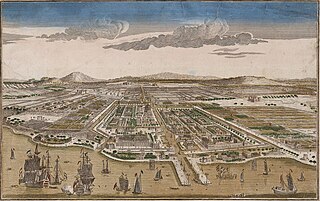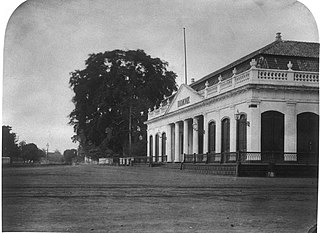
Istana Negara is one of the seven presidential palaces of Indonesia. It is located on Veteran Street in Central Jakarta, with Merdeka Palace located south. It is part of the presidential palace compound which has a total area of 68,000 m², along with three other buildings: Bina Graha which was formerly used as the President's Office, Wisma Negara on the western side which is used as the state guest house, and the office for the Ministry of State Secretariat of Indonesia. Istana Negara faces north towards the aforementioned street, while the Merdeka Palace faces Merdeka Square and the National Monument (Monas).

The Merdeka Palace, is one of seven presidential palaces in Indonesia. It is located on the north side of the Merdeka Square in Central Jakarta, Indonesia, and was used as the official residence of the president of the Republic of Indonesia.

Menteng is a district in the administrative city of Central Jakarta, Indonesia. Menteng is surrounded by the districts of Senen and Matraman to the east, Tebet and Setiabudi to the south, Tanah Abang to the west, and Gambir to the north. Menteng is bound by the West Flood Canal to the west, Ciliwung River to the south and east, and Kebon Sirih Road to the north. Menteng is the district seat of the Central Jakarta government.

Sawah Besar is a district (kecamatan) of Central Jakarta, Indonesia. Its neighborhoods are among the most historic, containing the 1820-established Pasar Baru, the new colonial city – Weltevreden – and the old course of the Ciliwung River. Landmarks include the Lapangan Banteng, the government's 19th century, low-rise A.A. Maramis Building and its high palmed-lawned vista, and Jakarta Cathedral.

Jakarta is Indonesia's capital and largest city. Located on an estuary of the Ciliwung River, on the northwestern part of Java, the area has long sustained human settlement. Historical evidence from Jakarta dates back to the 4th century CE, when it was a Hindu settlement and port. The city has been sequentially claimed by the Indianized kingdom of Tarumanegara, the Hindu Kingdom of Sunda, the Muslim Sultanate of Banten, and by Dutch, Japanese and Indonesian administrations. The Dutch East Indies built up the area before it was taken during World War II by the Empire of Japan and finally became independent as part of Indonesia.

Ancol is a coastal lowland area located to the east of Kota Tua Jakarta in northern Jakarta, in Indonesia. The coastal lowland stretched from Kota Tua Jakarta to the west and Tanjung Priok to the east. Today, Ancol contains the main beach resort of Jakarta. Taman Impian Jaya Ancol, the largest integrated tourism area in Southeast Asia, is located in Ancol.

Colonial buildings and structures in Jakarta include those that were constructed during the Dutch colonial period of Indonesia. The period succeeded the earlier period when Jakarta, governed by the Sultanate of Banten, were completely eradicated and replaced with a walled city of Batavia. The dominant styles of the colonial period can be divided into three periods: the Dutch Golden Age, the transitional style period, and Dutch modernism. Dutch colonial architecture in Jakarta is apparent in buildings such as houses or villas, churches, civic buildings, and offices, mostly concentrated in the administrative city of Central Jakarta and West Jakarta.

The Jakarta Art Building, historically known as Schouwburg Weltevreden, is a concert hall in Sawah Besar, Central Jakarta, Indonesia, built during the colonial period in Batavia, Dutch East Indies.

Jalan H.R. Rasuna Said or Jalan Rasuna Said is one of the main avenues of Jakarta, Indonesia. It was constructed during the 1970s. It is located in the Golden Triangle of Jakarta. The road was named after Hajjah Rangkayo Rasuna Said, a National Hero of Indonesia. The road runs 4.9 km (3.0 mi) from Setiabudi, South Jakarta, to Tendean, Mampang Prapatan, South Jakarta. The Rasuna Said Street is also one of the Odd–even Traffic Restriction Scheme implementation zones.

Pieter Adriaan Jacobus "Piet" Moojen was a Netherlands-Indies architect, painter and writer. He studied architecture and painting in Antwerp. He lived and worked in the Dutch East Indies from 1903 to 1929. He was one of the first architects to implement Modernism in the Dutch East Indies. Moojen became widely known for his work on the Dutch entry at the Paris Colonial Exposition in 1931. He was active as an architect between 1909 and 1931.

Lapangan Banteng is a historic square located in a historic area formerly known as Weltevreden, today Sawah Besar subdistrict, Central Jakarta, Indonesia.

The Harmony Society was an elite social club in Batavia, Dutch East Indies. It was the oldest clubhouse in Asia when it was demolished. The construction of the group's building included the former bricks of the wall of Old Batavia. It was demolished for road widening and parking area in 1985. Activities at the club included cards and billiards. Indigenous people were excluded from the club.

Indies Empire style is an architectural style that flourished in the colonial Dutch East Indies between the middle of the 18th century and the end of the 19th century. The style is an imitation of the neoclassical Empire Style which was popular in mid-19th-century France. Conformed to the tropical setting of Indonesia, the style became known in the Dutch East Indies as the Indies Empire style.

Kim Tek Ie Temple, also called Vihara Dharma Bhakti, also known as 金德院, is a klenteng located in the China Town neighborhood of Glodok, Jakarta, Indonesia. Completed in 1650, Vihara Dharma Bhakti is the oldest Chinese temple in Jakarta.

The A.A. Maramis Building is an early 19th-century building in Jakarta, Indonesia. It hosts the headquarters of the Indonesian Ministry of Finance.

Jakarta City Hall is the seat of the Jakarta City government. The complex contains the official office of the governor and the vice governor of Jakarta, and the main administrative office. Jakarta City Hall is located south of Merdeka Square.

Jalan Gajah Mada and Jalan Hayam Wuruk, formerly Molenvliet West and Molenvliet Oost respectively, is a major thoroughfare located in Jakarta, Indonesia. The two streets with its canal, the Batang Hari, connect Glodok and Kota Tua Jakarta to the north with Harmoni Junction to the south. Completed in late 1640s, the canal-street Gajah Mada and Hayam Wuruk is Jakarta's oldest major thoroughfare.

G. Kolff & Co., was a firm specializing in bookselling, publishing and printing based in Batavia.

Marine Hotel was one of the former landmark of the Molenvliet, a 17th-century built canal located in Batavia, the Dutch East Indies. Marine Hotel was located at the south end of Molenvliet West, approximately at the location of the old building of Bank Tabungan Negara. The building has been demolished.
Hotel Sriwijaya is a three-stars hotel located in Jakarta, Indonesia. The building of Hotel Sriwijaya has always been a hotel for over 125 years. Hotel Sriwijaya is the oldest surviving hotel building in Jakarta.





















